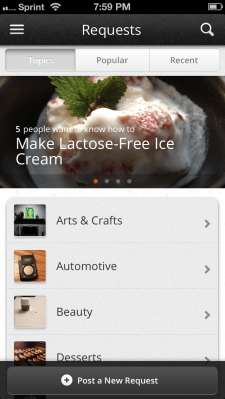Snapguide — the how-to app now that capitalizes on the ubiquity of smartphones and tablets in our lives to encourage us to create guides for everything from cooking to crafting and eyelash curling — is today releasing an update that it hopes will spur users to become more interactive with the service, even if they themselves lack the motivation to create guides themselves. A new iOS update (for iPhone and iPad) will let users start making requests for new guides, along with new interface updates that will help them better navigate the content that is already there.
The moves are a sign of how Snapguide hopes to keep people engaged on the site as it continues to grow. That growth has been coming at a steady pace: when we last wrote about Snapguide in February, it had 1 million unique monthly users; today that number is up to 2 million and growing at a rate of between 12 percent and 15 percent per month, according to CEO and founder Daniel Raffel.
Raffel also tells me that some 3 percent to 4 percent of users are creating content these days, up from the 1 percent that typically provide the content on social networks. The idea is that making guide requests could see that number increase, not only by encouraging more content from Snapguide’s emerging base of power-users, but also by getting users who are not creating guides to start offering more ideas of what they would like to see. And those who don’t have ideas to suggest can vote up requests made by others.
It will be interesting to see how far Snapguide’s free creation and free consumption model will take it for growth. It seems like the forces around the platform are more commercial than not. When Raffel first told me about the request feature, I think one of my first questions was whether users can ask for payments for guides — with the idea of this becoming a kind of marketplace for content or a platform for mini-apps, a micro-appstore.
This seems to detract from the main point, though: “We could focus on giving people a one stop production shop for selling content, but the thing that interests me is that to get to the path where people are sharing things that are free is actually more interesting,” says Raffel. “That allows people to create a community that is passionate. As soon as you introduce money, that changes the vibe, and the culture.
“It’s not something I’m adverse to or think it’s incorrect, but for us to introduce it we still have a lot of work to do to make the best free tools.”
Apart from my prying questions, while Snapguide has continued to remain a free platform, it is increasingly getting appropriated by brands anyway, something that it’s happy to encourage without formalizing things too much. Those brands include Build.com, Real Simple, Kate Spade New York, Steve Madden and publications such as BARE Magazine.
“We’re still focused on organic growth,” Raffel says. “No business deals or making money on the side. No one paying to get content promoted. No plans for ads.” That doesn’t mean it won’t in the future: “I think it’s safe to say we’re not going to avoid it forever; at some point in time we may have something like sponsored ads or paid content.”
And with brands clearly interested in the platform, it will be interesting to watch how Snapguide adds further features like video longer term — being a medium that will put Snapguide in closer competition with YouTube and also more advertising friendly. “We don’t discourage it but we haven’t encouraged it,” Raffel says of video today. “If and when we invest in it we want to make sure we differentiate ourselves from YouTube. We don’t want to be another video hosting site.” Right now, Snapguide supports 60 second clips. “We want things that you can follow along, and that length lends itself to that,” he says.
